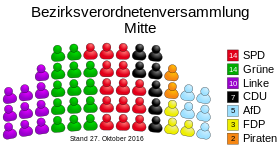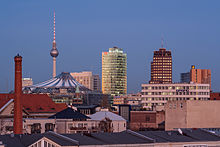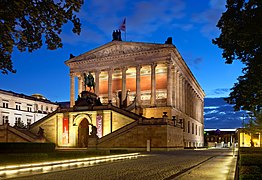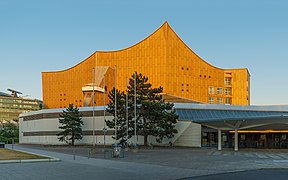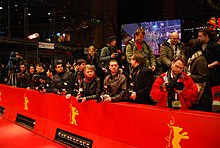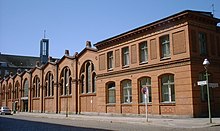Mitte district
|
Middle 1st district of Berlin |
||||||||||||||||||||||
|---|---|---|---|---|---|---|---|---|---|---|---|---|---|---|---|---|---|---|---|---|---|---|
| Coordinates | 52 ° 31 ′ 0 ″ N , 13 ° 24 ′ 0 ″ E | |||||||||||||||||||||
| surface | 39.47 km² | |||||||||||||||||||||
| Residents | 385,748 (Dec. 31, 2019) | |||||||||||||||||||||
| Population density | 9773 inhabitants / km² | |||||||||||||||||||||
| Proportion of foreigners | 32.6% (Dec. 31, 2016) | |||||||||||||||||||||
| Unemployment rate | 9.2% (Oct. 2018) | |||||||||||||||||||||
| Post Code | 10115, 10117, 10119, 10178, 10179, 10551, 10553, 10555, 10557, 10559, 10785, 10787, 13347, 13349, 13351, 13353, 13355, 13357, 13359, 13407, 13409 | |||||||||||||||||||||
Administration address |
City Hall Tiergarten Mathilde-Jacob-Platz 1 10551 Berlin |
|||||||||||||||||||||
| Website | www.berlin-mitte.de | |||||||||||||||||||||
| Average age | 38.9 years (Dec. 31, 2016) | |||||||||||||||||||||
| structure | ||||||||||||||||||||||
| District key | 01 | |||||||||||||||||||||
| Structure of the district | ||||||||||||||||||||||
| politics | ||||||||||||||||||||||
| District Mayor | Stephan von Dassel ( Greens ) | |||||||||||||||||||||
| Deputy District Mayor | Ephraim Gothe ( SPD ) | |||||||||||||||||||||
| Allocation of seats ( district assembly ) | ||||||||||||||||||||||
|
||||||||||||||||||||||
Mitte is the first administrative district of Berlin and had 385,748 inhabitants as of December 31, 2019. It is the second youngest in terms of average age in the metropolis.
The district was created in 2001 with the Berlin administrative reform by merging the previously independent districts of Wedding , Tiergarten and Mitte .
Both the seat of government and most of the constitutional organs of the Federal Republic of Germany are located in the Mitte district . The same applies to the Berlin Senate .
A large number of branches of international companies have settled in Berlin- Mitte . Global awareness is also due to numerous cultural institutions and due to its position as an incubator.
geography
Location and description
The Mitte district borders the Reinickendorf district in the north, the Pankow district in the east and the Friedrichshain-Kreuzberg district in the southeast . In the south it shares the district border with the Tempelhof-Schöneberg district and in the west it borders on the Charlottenburg-Wilmersdorf district .
Settlement structure
The majority of the district is relatively densely populated with an average population density that is twice as high as in general in Berlin. The Tiergarten district is an exception, and its population density is only half that of Berlin. The Hansaviertel is the smallest of the 96 districts in Berlin in terms of area.
Districts
It is one of two districts (next to Friedrichshain-Kreuzberg ) that consist of parts of the former East and West Berlin . In common parlance, Mitte continues to refer to today's district of Berlin-Mitte and not the new merger district.
The Mitte district is divided into six districts :


| District and locations | Area (km²) | Resident December 31, 2019 |
Inhabitants per km² |
location |
|---|---|---|---|---|
| 0101 center | 10.70 | 102,465 | 9,576 | |
| 0102 Moabit | 7.72 | 80,495 | 10,427 | |
| 0103 Hansaviertel | 0.53 | 5,926 | 11,181 | |
| 0104 Tiergarten | 5.17 | 14,881 | 2,878 | |
| 0105 Wedding | 9.23 | 86,806 | 9,405 | |
| 0106 Gesundbrunnen | 6.13 | 95,175 | 15,526 |
Streets and squares
- (Selection)
ecology
In the Mitte district there is an extensive network of mixed water sewers, into which household wastewater, but also rainwater from open spaces such as squares, streets and backyards, is collected and transported away. Due to the mixture of rainwater and sewage, so-called heavy rain events lead to local overloads in the sewer network, which lead to untreated mixed sewage being discharged into the Spree. The bottom of the Spree, like other inner city waters in Berlin, is also affected by deposits of bulky waste and electronic waste.
history

The old Berlin came at a bifurcation of the Spree , so that a shallow ford emerged with many sandbars. The first fishermen settled on a raised sandbank in the middle of the Spree (called: Fischerinsel on the Spreeinsel von Berlin) and a market town developed - at the Molkenmarkt stood the Roland von Berlin, he is now at the Märkisches Museum .
The two arms of the Spree are currently heavily rebuilt, with Museum Island in the north of the island . In the middle there used to be the Berlin City Palace (blown up in 1950) and in the same place since 1976 the Palace of the Republic , the demolition of which was finished in 2009. On the east bank of the Spree, a large square with the television tower extends to Alexanderplatz . Not far from the Fischerinsel and the Molkenmarkt are the Red Town Hall and the Nikolaiviertel with the oldest church in Berlin.
The district since 2001
The central district was created in 2001 with the Berlin administrative reform by merging the previously independent districts of Wedding , Tiergarten and Mitte .
population
On December 31, 2019, the Mitte district had 385,748 inhabitants on an area of 39.5 square kilometers. Thus, on the reference date, the population density was 9,773 inhabitants per square kilometer. On December 31, 2016, the proportion of foreigners was 32.6 percent, while the proportion of the population with a migration background was 50.8 percent on the reference date. Both values were the highest in all Berlin districts . The unemployment rate amounted on 30 April 2013, 14.1 percent. As of December 31, 2016, the median age of the population was 38.9 years.
| category | 2001 | 2011 | 2017 |
|---|---|---|---|
| German and foreign residents | 318,082 | 333.152 | 373,944 |
| Average age | 39.2 | 39.2 | 38.9 |
| German citizens (total) | 232.079 | 241,590 | 251.263 |
| German citizens without a migration background | 180,775 | 182.734 | |
| German citizens with a migration background | 60,815 | 68,529 | |
| Foreign nationals | 86.003 | 91,562 | 122,681 |
| Foreigners and residents with a migration background | 152.377 | 191.210 | |
| Germans (nationals) in total | 241,590 | 247.277 | |
| Proportion of Germans without a migration background | 54.3% | 48.9% | |
| Proportion of Germans with a migration background | 18.3% | 18.3% | |
| Share of residents with foreign citizenship | 27.5% | 32.8% | |
| Total number of Germans with a migration background (in the district) | 60,815 | 68,529 | |
| - * from the EU | 10.187 | 11,711 | |
| - * from the former Yugoslavia | 2,652 | 2,888 | |
| - * from the former Soviet Union | 5,342 | 6.096 | |
| - * from Islamic countries | 27,137 | 30,311 | |
| - * from Vietnam | 856 | 1,068 | |
| - from the USA | 588 | 933 | |
| Foreign residents (in the district) | 91,562 | 122,681 | |
| - from the EU | 29,282 | 48,688 | |
| - from the former Yugoslavia | 8,900 | 8,821 | |
| - from the former Soviet Union | 6,204 | 8,311 | |
| - from Islamic countries | 34,960 | 41,287 | |
| - from Vietnam | 1,296 | 1,458 | |
| -- from the USA | 1,792 | 2,956 |
language
Over 30% of the population in the Mitte district speak 2 or more languages. Due to the high proportion of immigrant families in Berlin-Mitte, an urban ect based on the German language has developed in some districts .
economy
Of the twelve Berlin administrative districts, the Mitte district is one of the least economically developed. The GDP per inhabitant in 2018 was below the Berlin average and below the average achieved in Germany. The resident companies and businesses produce only below-average added value with their services and products and only achieve low profitability.
On the other hand, a start-up scene has developed in the district since 2000, which is attracting international talent and young entrepreneurs. Some of the most important venture capitalists in Germany are based in Berlin-Mitte.
Innovation and commercial locations

There are three larger industrial and commercial areas in the district:
Moabit-West: A large number of small and medium-sized businesses have settled on the 43 hectare area between Sickingenstrasse and Huttenstrasse. However, the location is primarily characterized by large-scale operations such as Siemens, which produces gas turbines there for the world market. To the north of the S-Bahn ring is the Berlin wholesale market with the Fruchthof Berlin and the Westhafen.
Fennstrasse: The site is around 14 hectares and is located on Fennstrasse and Sellerstrasse in the Wedding district. The defining company here is Bayer AG .
Humboldthain: Mainly smaller companies have settled at this 21 hectare research, development and production site. The former AEG factories, which are reminiscent of the time of the industrial metropolis of Berlin at the end of the 19th century, are distinctive for the location . They house the first German start-up center (BIG) with the technology and innovation park (TIB), founded in the 1980s.
tourism
A large number of hotels have settled in Berlin-Mitte. Due to the central location, the proximity to the government district, the many local cultural institutions and the numerous festivals, most of the overnight stays are in the Mitte district. Over 40% of all hotel overnight stays in Berlin take place here. The most famous hotels include the Hotel Adlon , The Ritz-Carlton Berlin and the Park Inn by Radisson Berlin Alexanderplatz .
retail trade
With Alexanderplatz , Friedrichstrasse , Potsdamer Platz and the area around Hackescher Markt , the district has four major retail locations that are frequented by local, national and international customers. Other shopping streets in the district are u. a. the Müllerstraße , the Tower Street , the Bath Street and the Potsdamer Straße . The most famous department stores in Mitte include the Galeries Lafayette Berlin , the Kulturkaufhaus Dussmann , the Galeria Kaufhof Berlin-Alexanderplatz , and the Quartier 206 .
Companies
- (Selection)
- Deutsche Bahn AG , transport and logistics, company headquarters
- AVM , telecommunications and network technology, company headquarters
- N26 , financial services, company headquarters
- Bayer Pharma , subsidiary of Bayer AG
- Total , mineral oil company, German headquarters
- SAP , software, Berlin branch
- Gazprom Germania , gas supplier, subsidiary of Gazprom Export
- Sanofi , pharmaceutical company, German headquarters
- Klarna , financial services, German headquarters
- Bombardier Transportation , rail vehicle construction, German headquarters
- Pfizer , pharmaceutical company, German headquarters
- 50Hertz Transmission , transmission system operator , subsidiary of Elia System Operator
- Deutsche Kreditbank , financial services, subsidiary of Bayerische Landesbank
- Berlin wholesale market with Fruchthof Berlin
Creative industry and media
In 2015, most of the companies in Berlin's creative industries were located in the Mitte district.

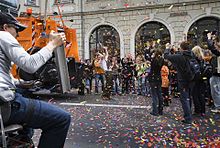
- (Selection)
- BMG , music publisher, subsidiary of Bertelsmann
- Focus editorial team
- Exberliner , English-language city magazine
- Dummy , society magazine
- Capital , business magazine
- Business Punk , business magazine
- Start-up scene , internet magazine
- ARD capital studio
- DW-TV , international TV station
- ZDF representative office in Zollernhof
- BBC Germany headquarters
- Agence France-Presse , French news agency
- Scholz & Friends , advertising agency, subsidiary of WPP
- ResearchGate , social network for scientists
- Il Mitte , Italian-language city magazine
Infrastructure
Private transport
The federal highways B 1 , B 2 , B 5 and B 96 run through the Mitte district .
Transportation
With the S-Bahn lines S1, S2, S3, S5, S7, S9, S25, S26, S41, S42 and S75 as well as the underground lines U1 , U2 , U5 , U6 , U8 , U9 and U55 the District connected to public transport .
A new section of the U5 underground line is currently under construction (planned completion: 2020). The tunnel work for the S21 S-Bahn project is also in the construction phase .
Waterways for shipping

Structural and civil engineering
The origins of Berlin's urban development lie in the area of the Mitte district, which has existed since 2001. As early as 1747, around 100,000 people lived in the city . Since then, the area has gone through several phases of urban renewal. With the Hobrecht Plan , essential civil engineering works for the sewer system were realized from 1862, which still exist today.
The north-south S-Bahn tunnel was built in the 1930s and, with a length of 5884 meters, is the longest S-Bahn tunnel in the city. The Tiergarten Spreebogen tunnel , completed in 2006, is the longest road tunnel in Berlin with a length of 2392 meters . The 3453 meter long north-south long-distance railway tunnel, also completed in 2006, is the longest underground civil engineering work for long-distance trains.
Notable high-rise buildings have been erected in what is now the Mitte district since the end of the 19th century. The Berlin Cathedral , built in 1905, is currently 98 meters tall and is the tallest church building in Berlin. At the time of its opening , the Berlin television tower , completed in 1969, was the third tallest free-standing structure in the world at 368 meters. Since 1990 it has been the tallest structure in Germany and the second tallest in the European Union. With a height of 125 meters, the Park Inn by Radisson Berlin Alexanderplatz , completed in 1970, is currently the second highest hotel building in Germany (as of 2020). The hospital building of the Charité , opened in 1982, is the tallest hospital building in Germany with a height of over 72 meters.
politics
District Assembly
The election to the District Assembly (BVV) of the District Mitte on September 18, 2016 resulted in the following distribution of seats:
| Political party | Seats |
|---|---|
| Alliance 90 / The Greens | 14th |
| SPD | 14th |
| The left | 10 |
| CDU | 7th |
| AfD | 5 |
| FDP | 3 |
| Pirates | 2 |
| All in all | 55 |
District Mayor
- 2001-2006: Joachim Zeller (CDU)
- 2006–2016: Christian Hanke (SPD)
- since 2016: Stephan von Dassel (Alliance 90 / The Greens)
The mayors of the former Mitte district and today 's Mitte district can be found there .
In the Berlin districts, a counting community (unlike in the state parliaments of the Federal Republic of Germany) is not linked to a coalition , so that the parliamentary groups seek majorities for each other. From 2011 to 2016 there was a counting community of the SPD and CDU.
The Mitte district is represented at the state level in the Council of Mayors and in the Resource Management Working Group .
District Office
Members of the district office are (as of 2020):
- Stephan von Dassel (Bündnis 90 / Die Grünen), district mayor
- Ephraim Gothe (SPD), District Councilor, Deputy District Mayor
- Sabine Weißler (Alliance 90 / The Greens), District Councilor
- Ramona Reiser (Die Linke), District Councilor
- Carsten Spallek (CDU), District Councilor
coat of arms
The coat of arms of the Mitte district was redesigned and redesigned by the heraldist Theodor Lorenz (born April 6, 1929, † March 25, 2005) after the merging of the three districts of Mitte (old district) , Tiergarten and Wedding . Today's coat of arms was awarded on October 9, 2001 by the Berlin Senate .
Blazon : The shield, sixfold in red and silver, is covered with a golden central shield, inside a growing black, red-armored and tongued bear, which holds a blue shield with an upright golden lily scepter in its paws. A red three-tower wall crown rests on the shield , the central tower of which is covered with the Berlin coat of arms .
Reasons for the coat of arms: The colors of red and silver correspond to the historical city colors of Berlin. The heart sign with the Berlin bear refers to the former Mitte district as the historical center of Berlin, just as the location in the fanned shield division indicates the central location of the district. The small shield with the scepter was already the heart shield in the coat of arms of Dorotheenstadt - it is a sign of the ruling power and refers to the historical role of Berlin as the royal seat and capital of several German states. The crown of the wall is the connecting element of all Berlin districts .
Town twinning

International Higashiōsaka , Japan (since 1959, then founded with the old Wedding district and the Japanese Fuse) Cholon , Israel (friendly relations since 1970, twin town since 1980, then established with the old Wedding district) Tourcoing , France (since 1995, then with founded in the old district of Wedding ) Shinjuku (since 1994), the heart of the Japanese capital Tokyo Tsuwano (since 1995) going back to the scholar Mori Ogai , who lived for some time in Berlin Terézváros (district of Budapest ), Hungary (since 2005) Beyoğlu ( District of Istanbul ), Turkey (since 2008)
![]()
![]()
![]()
![]()
![]()
![]()
![]()
National
- Kassel , Germany (since 1962)
- Bottrop , Germany (since 1983)
- Schwalm-Eder-Kreis , Germany (friendship between cities since 1979, twin town since 1992)
Institutions of the State of Berlin
- Red townhall
- Berlin House of Representatives in the former Prussian state parliament
- Senate administrations
- Service building in the middle of the Berlin fire brigade (authority management, staff, central service)
- Directorate 3 of the Berlin State Police
government District
In the Mitte district there is the government quarter with the most important institutions of the federal government with its ministries and the German Bundestag , the parliament of the Federal Republic of Germany, as well as numerous embassies and state representations;
- German Bundestag in the Reichstag building
- Federal Chancellery
- Federal Council in the Prussian manor house
- Federal Ministries
- Members ' offices in the Paul-Löbe-Haus and in the Marie-Elisabeth-Lüders-Haus
- Bellevue Palace as the seat of the Federal President
- German Parliamentary Society in the historic Reichstag Presidential Palace
- Representations of the countries
- Federal Intelligence Service
- Embassies in the Tiergarten district
- Julius-Leber-Kaserne with the Bundeswehr Territorial Tasks Command
education
Public schools
There are a total of 32 primary schools and two primary levels at community schools in the district. A primary school is under construction. 15,549 pupils attended a primary school in the district in the 2017/2018 school year. In addition to the two community schools, there are nine integrated secondary schools (ISS), seven grammar schools and four special schools. At the beginning of the 2017/2018 school year, the number of pupils in the integrated secondary schools was 5539 and in the grammar schools 4833.
Among the most popular secondary schools in Berlin, the Herbert Hoover School (ISS) in Gesundbrunnen took seventh place and the Heinrich von Stephan Community School in Moabit took eighth place. The Lessing-Gymnasium in Wedding was listed in second place among the grammar schools .
There are also seven private primary schools, two private integrated secondary schools, four private grammar schools, two private community schools and one Waldorf school.
Colleges
- Humboldt University
- European School of Management and Technology
- Charité University Medicine
- Hertie School of Governance
- Beuth University of Technology
- Ernst Busch Academy of Dramatic Arts
- University of Music "Hans Eisler"
- University for Media, Communication and Economics
research
Libraries
- Medical library of the Charité
- Jacob and Wilhelm Grimm Center
- State Library Unter den Linden
- Library of the German Bundestag
- Berlin-Mitte City Library
architecture
Like the city of Berlin, the Mitte district is not known for its outstanding architecture. Nevertheless, individual buildings were created in different epochs that have given the area a high quality of life or have become attractions.
Buildings
- Brandenburg Gate
- Berlin TV tower
- House of World Cultures
- Old town house
- Soviet memorial
- Carillon
- Berlin Victory Column
Sacred building
Culture
Some of the nationally and internationally most famous cultural institutions in the metropolis of Berlin are located in the Mitte district.
Gorilla in the zoological garden
Dance revue in the Friedrichstadt-Palast
Fashion show at Fashion Week
Museums
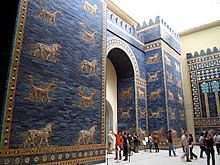
- Museum Island :
- Hemp Museum
- Zeughaus Berlin contains the German Historical Museum
- Schinkel Museum in the Friedrichswerder Church
- New National Gallery
- Museum of Communication
- Märkisches Museum
- Museum of Natural Science
- Ephraim Palace
- Heinrich Zille Museum
- Kupferstichkabinett
- Gay museum
- Musical Instrument Museum Berlin
- Garlic house
- German Kinemathek
- Bauhaus Archive
- Picture gallery
Stages
- Admiralspalast
- ATZE music theater
- Berlin Ensemble
- Culture factory Moabit
- Berlin Philharmonic
- chameleon
- German theater
- Friedrichstadt Palace
- Grips Theater
- Weird opera
- Maxim Gorky Theater
- Prime time theater
- Schauspielhaus Berlin
- State Opera Unter den Linden
- Volksbühne
- Winter garden
Cinemas
- (Selection)
- ACUD
- Central
- Cineplex Alhambra
- City Kino Wedding
- Cubix
- Filmrauschpalast in the Kulturfabrik
- Hackesche Höfe movie theater
- Kino International
- Babylon cinema
freetime and sports
The district had 40 general sports facilities including four indoor swimming pools of the Berliner Bäder-Betriebe and 43 school sports facilities in 2016. The largest sports facilities include the Post Stadium with a seating capacity of 10,000, the Rehberge Stadium and the Erika-Hess Ice Stadium .
In addition to 259 public playgrounds, there were 222 public green spaces in 2016. The largest green spaces are: Großer Tiergarten , Fritz-Schloß-Park , Volkspark Rehberge and Volkspark Humboldthain .
With at least 32 fitness studios in 2019, the district is at the top of Berlin.
The Berlin Marathon , one of the world's largest running events, begins and ends in the Tiergarten near the Brandenburg Gate . More than 40,000 runners take part in the competition. According to the average times of the top ten results for men and women, the route is the fastest in the world.
Events
Numerous internationally important events take place on Pariser Platz , Alexanderplatz , Gendarmenmarkt , Unter den Linden boulevard and Strasse des 17. Juni and other outstanding urban planning locations.
(Selection)
- Christopher Street Day Parade
- Celebration of the Day of German Unity
- New Year's Eve celebration at the Brandenburg Gate
- Fan mile for the European Football Championship and World Cup
- Berliner Volksfestsommer (formerly: Franco-German Volksfest ) on the central fairground in Wedding
- Berlinale
- Berlin Fashion Week , Berlin fashion shows
- Christmas markets at Gendarmenmarkt, Potsdamer Platz, Opernpalais, Rotes Rathaus and Alexanderplatz
- Neighborhood festivals, such as the Torstraßenfest, and numerous demonstrations and rallies due to the central location of the district.
- Earth Hour
- Environmental Festival (ADFC Sternfahrt )
Clubs and restaurants
The most famous clubs in Mitte include the Golden Gate , the KitKatClub , the Weekend, the Tresor and the Soho House Berlin (as of 2019).
Over two thirds of the 23 restaurants in Berlin that were awarded Michelin stars in 2019 are located in the Mitte district. The most famous cafes include u. a. the Café am Neuen See, the St. Oberholz and the Café Einstein Unter den Linden . In addition, an extremely diverse bar scene has established itself in Mitte.
The Arminiusmarkthalle is an important address in the Moabiter Kiez.
See also
Web links
- Official website of the Mitte district of Berlin
- Current construction projects in the Mitte district of Berlin
Individual evidence
- ↑ a b c d Statistical report - residents in the state of Berlin on December 31, 2016 (PDF; 3.1 MB). Office for Statistics Berlin-Brandenburg . Retrieved June 25, 2016.
- ↑ a b Labor market overview - reporting month October 2018 - middle . In: statistik.arbeitsagentur.de, accessed on October 30, 2018.
- ↑ Numbering according to the district key
- ↑ Startup Genome presents its Global Startup Ecosystem Report 2017. Berlin lands in seventh place in the world rankings, BerlinValley, accessed on June 29, 2017.
- ↑ a b Residents in the State of Berlin on December 31, 2019, data from the Berlin-Brandenburg Statistics Office , accessed on August 27, 2020 ( PDF file ) ( help on this ).
- ↑ Combined sewer systems and their overflows , Flussbad Berlin, accessed on February 2, 2020.
- ↑ Diving athletes get a lot of rubbish from the Spree , Berliner Woche, accessed on February 2, 2020.
- ↑ Statistical report AI 5 - hj 2/11 - residents in the state of Berlin on December 31, 2011
- ↑ Statistical report AI 5 - hj 1/17 inhabitants in the state of Berlin on June 30, 2017
- ↑ Berlin- a city with many languages , mr-artographie.de, accessed on January 18, 2020.
- ↑ Health and Social Report 2018 , District Office Mitte, accessed on January 26, 2020.
- ^ The world's top cities face stiff competition, here's why , World Economic Forum, accessed February 1. 2020.
- ^ Senate Department for Urban Development: Urban Development Plan for Industry and Commerce. (PDF) 2011, accessed April 6, 2018 .
- ↑ Corinna Visser: The turbines turn more slowly . In: Der Tagesspiegel Online . December 20, 2012, ISSN 1865-2263 ( tagesspiegel.de [accessed April 6, 2018]).
- ↑ The Senate , Der Tagesspiegel, accessed on February 1, 2020, is building on these centers .
- ↑ Tourism statistics in Berlin districts , visitberlin, accessed on January 23, 2020.
- ↑ Retail and center concept. September 2, 2014, accessed April 6, 2018 .
- ↑ N26, Revolut, Klarna - Berlin advances to become the fintech capital of Europe , start-up scene, accessed on February 1, 2020.
- ↑ Culture and Creative Industries Index Berlin - Brandenburg 2015 , PDF page 11, Berlin.de, accessed January 30, 2020.
- ↑ City magazine 'Il Mitte': Italians tell their Berlin. At: cafébabel.de , accessed on July 3, 2017.
- ↑ Look, Gotthard! Berlin also has a couple of (relatively) long tunnels , BZ, accessed on January 30, 2020.
- ↑ Berlin church towers , Berlin church towers, accessed on January 30, 2020.
- ↑ a b The regional returning officer for Berlin
- ↑ Elections for the District Assembly 2016
- ^ Council of Mayors - accessed on May 18, 2019
- ↑ Small request from the FDP - accessed on May 18, 2019
- ^ Members of the District Office
- ↑ National emblem of Berlin - district coat of arms , accessed on January 28, 2020.
- ↑ Berlin fire brigade locations. At: Berlin.de , accessed on June 30, 2017.
- ↑ Representations of the federal states in the federal capital , Berlin.de, accessed on June 24, 2017.
- ^ The School Department. January 2, 2018, accessed January 18, 2018 .
- ↑ Handover of the new “Europacity Mitte” primary school to the Mitte district. October 18, 2017, accessed January 18, 2018 .
- ↑ Measures and Finances. April 23, 2018. Retrieved April 24, 2018 .
- ^ Heinrich-von-Stephan-Schule - Community school in Berlin. Retrieved January 18, 2018 (German).
- ^ R. Köhler and F. Anders: These are Berlin's most popular secondary schools . ( Morgenpost.de [accessed on January 18, 2018]).
- ↑ City of Horrors , Der Tagesspiegel, accessed on January 23, 2020.
- ^ Mood killer , Süddeutsche Zeitung, accessed on January 23, 2020.
- ^ Filmrauschpalast - The independent Kiez cinema in Moabit. Retrieved January 18, 2018 .
- ↑ The Mitte district and its districts. July 10, 2017. Retrieved April 19, 2018 .
- ^ Stadium Rehberge, BSC Rehberge 1945 - Stadium World . In: Stadium World . ( stadionwelt.de [accessed on April 13, 2018]).
- ↑ The Mitte district and its districts. July 10, 2017. Retrieved April 19, 2018 .
- ↑ Fitness studios in Berlin , Berlin.de, accessed on January 23, 2020.
- ↑ World's Fastest Marathon Courses - Men. (No longer available online.) Archived from the original on November 7, 2017 ; Retrieved July 18, 2017 (UK English).
- ↑ There is a three-day block for 20,000 euros. Retrieved January 18, 2018 .
- ↑ Christopher Street Day Parade. December 20, 2017, accessed on January 18, 2018 (German).
- ↑ These are the new star restaurants in Berlin , Berliner Morgenpost, accessed on January 23, 2020.



